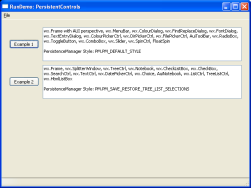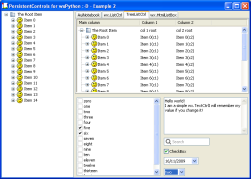Infinity77



Freeware
- Shipped With wxPython
- Unofficial Widgets
- BalloonTip
- ExtendedChoice
- EnhancedStatusBar
- ToasterBox
- SpeedMeter
- AdvancedSplash
- ShapedButton
- PieCtrl/ProgressPie
- NotebookCtrl
- FloatSpin
- ThumbnailCtrl
- PyAUI
- PyProgress
- KnobCtrl
- FourWaySplitter
- RulerCtrl
- LabelBook
- FlatMenu
- WindowTree
- WidgetStack
- HyperTreeList
- PyCollapsiblePane
- CubeColourDialog
- AquaButton
- GenericMessageDialog
- GradientButton
- MultiDirDialog
- PeakMeterCtrl
- SuperToolTip
- AUI
- UltimateListCtrl
- RibbonBar
- PersistentControls
- XLSGrid
- Applications
If you have any request, or you would like to know how I built some of these software and interfaces, please feel free to drop me an e-mail.
PersistentControls
(16-Nov-2009)
Persistent objects are simply the objects which automatically
save their state when they are destroyed and restore it when they are
recreated, even during another program invocation.
Persistent Object Overview
Most often, persistent objects are, in fact, persistent windows as it
is especially convenient to automatically restore the UI state when the
program is restarted but an object of any class can be made persistent.
Moreover, persistence is implemented in a non-intrusive way so that the
original object class doesn't need to be modified at all in order to
add support for saving and restoring its properties.
The persistence framework involves:
- PersistenceManager which all persistent objects register themselves with. This class handles actual saving and restoring of persistent data as well as various global aspects of persistence, e.g. it can be used to disable restoring the saved data;
- PersistentObject is the base class for all persistent objects or, rather, adaptors for the persistent objects as this class main purpose is to provide the bridge between the original class -- which has no special persistence support -- and PersistenceManager;
- PersistentHandlers which handle different kind of saving/restoring actions depending on the widget kind.
Using Persistent Windows
wxPython has built-in support for a (constantly growing) number of controls. Currently the following classes are supported:
- wx.TopLevelWindow (and hence wx.Frame and wx.Dialog, together with their own AUI perspectives);
- wx.MenuBar, wx.lib.agw.flatmenu.FlatMenuBar;
- wx.lib.agw.aui.AuiToolBar;
- wx.Notebook, wx.Toolbook, wx.Treebook, wx.Choicebook, wx.aui.AuiNotebook,
- wx.lib.agw.aui.AuiNotebook (together with its own AUI perspective),
- wx.lib.agw.flatnotebook.FlatNotebook, wx.lib.agw.labelbook.LabelBook,
- wx.lib.agw.labelbook.FlatImageBook;
- wx.CheckBox;
- wx.ListBox, wx.VListBox, wx.HtmlListBox, wx.SimpleHtmlListBox, wx.gizmos.EditableListBox;
- wx.ListCtrl, wx.ListView;
- wx.CheckListBox;
- wx.Choice, wx.ComboBox, wx.combo.OwnerDrawnComboBox;
- wx.RadioBox;
- wx.RadioButton;
- wx.ScrolledWindow, wx.lib.scrolledpanel.ScrolledPanel;
- wx.Slider, wx.lib.agw.knowbctrl.KnobCtrl;
- wx.SpinButton, wx.SpinCtrl, wx.lib.agw.floatspin.FloatSpin;
- wx.SplitterWindow;
- wx.TextCtrl, wx.SearchCtrl, wx.lib.expando.ExpandoTextCtrl, wx.lib.masked.Ctrl;
- wx.ToggleButton, wx.lib.buttons.GenToggleButton, wx.lib.buttons.GenBitmapToggleButton, wx.lib.buttons.GenBitmapTextToggleButton, wx.lib.agw.shapedbutton.SToggleButton, wx.lib.agw.shapedbutton.SBitmapToggleButton, wx.lib.agw.shapedbutton.SBitmapTextToggleButton;
- wx.TreeCtrl, wx.GenericDirCtrl, wx.lib.agw.customtreectrl.CustomTreeCtrl;
- wx.gizmos.TreeListCtrl, wx.lib.agw.hypertreelist.HyperTreeList;
- wx.lib.calendar.CalendarCtrl;
- wx.CollapsiblePane;
- wx.DatePickerCtrl, wx.GenericDatePickerCtrl;
- wx.media.MediaCtrl;
- wx.ColourPickerCtrl, wx.lib.colourselect.ColourSelect;
- wx.FilePickerCtrl, wx.DirPickerCtrl;
- wx.FontPickerCtrl;
- wx.FileHistory;
- wx.DirDialog, wx.FileDialog;
- wx.FindReplaceDialog;
- wx.FontDialog;
- wx.ColourDialog, wx.lib.agw.cubecolourdialog.CubeColourDialog;
- wx.SingleChoiceDialog, wx.MultiChoiceDialog;
- wx.TextEntryDialog, wx.PasswordEntryDialog.
To automatically save and restore the properties of the windows of classes listed above you need to:
- Set a unique name for the window using `SetName()`: this step is important as the name is used in the configuration file and so must be unique among all windows of the same class;
- Call PersistenceManager.Register(window) at any moment after creating the window and then PersistenceManager.Restore(window) when the settings may be restored (which can't be always done immediately, e.g. often the window needs to be populated first). If settings can be restored immediately after the window creation, as is often the case for wx.TopLevelWindow, for example, then PersistenceManager.RegisterAndRestore(window) can be used to do both at once.
- If you want the settings for the window to be saved when your main frame is destroyed (or your app closes), simply call PersistenceManager.SaveAndUnregister(window) with no arguments.
Sample Usage
Example of using a notebook control which automatically remembers the last open page:
book = wx.Notebook(parent, wx.ID_ANY)
book.SetName("MyBook") # Do not use the default name!!
book.AddPage(page1)
book.AddPage(page2)
book.AddPage(page3)
if not PersistenceManager.RegisterAndRestore(book):
# Nothing was restored, so choose the default page ourselves
book.SetSelection(0)
Defining Custom Persistent Windows
User-defined classes can be easily integrated with PersistenceManager.
To add support for your custom class MyWidget you just need to:
- Define a MyWidgetHandler class inheriting from `AbstractHandler;
- Implement its GetKind() method returning a unique string identifying all MyWidget objects, typically something like "widget";
- Implement its Save() and Restore() methods to actually save and restore the widget settings using PersistentObject.SaveValue() and PersistentObject.RestoreValue() methods.
If
you want to add persistence support for a class not deriving from
wx.Window, you need to derive MyPersistentWidget directly from
PersistentObject and so implement its PersistentObject.GetName() method
too. Additionally, you must ensure that
PersistenceManager.SaveAndUnregister() is called when your object is
destroyed as this can be only done automatically for windows.
TODOs
- Find a way to handle wx.ToolBar UI settings as it has been done for wx.lib.agw.aui.AuiToolBar: currently wx.ToolBar doesn't seem to have easy access to the underlying toolbar tools;
- Implement handler(s) for wx.grid.Grid for row/columns sizes (possibly adding another style to PersistenceManager as wx.grid.Grid sets up arrays to store individual row and column sizes when non-default sizes are used. The memory requirements for this could become prohibitive if the grid is very large);
- Find a way to properly save and restore dialog data (wx.ColourDialog, wx.FontDialog etc...);
- Add handlers for the remaining widgets not yet wrapped (mostly in wx.lib).
License And Version
PersistentObjects library is freeware and distributed under the wxPython license.
Check the demo for an almost complete review of the functionalities.
 |
Download PersistentControls Download PersistentControlsDocs Python Files and Documentation |
|
 |
||